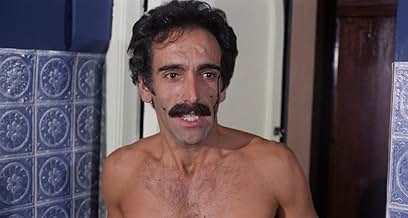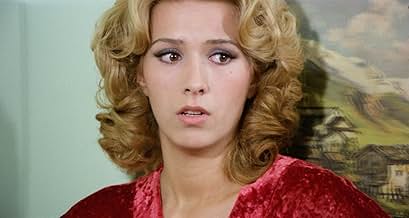AVALIAÇÃO DA IMDb
5,4/10
583
SUA AVALIAÇÃO
Adicionar um enredo no seu idiomaA writer arrives to an isolated boardinghouse run by a beautiful but strange woman. Shortly after his arrival, guests start to get violently killed.A writer arrives to an isolated boardinghouse run by a beautiful but strange woman. Shortly after his arrival, guests start to get violently killed.A writer arrives to an isolated boardinghouse run by a beautiful but strange woman. Shortly after his arrival, guests start to get violently killed.
- Direção
- Roteiristas
- Artistas
Heinrich Starhemberg
- Daniel
- (as Henry Gregor)
Tony García Jr.
- Young Boy
- (as Tony Garcia Pablo)
León Klimovsky
- Paisano
- (não creditado)
Avaliações em destaque
A writer stops off at a secluded bed and breakfast run by the battered wife of a mysterious man who spends all his time upstairs in his room. That is except when he's killing off the lodgers downstairs.
If you've seen more than 3 horror movies in your lifetime, the big twists in Trauma won't come as any big surprise, but it's not the worst film of its type and it keeps things entertaining. It features a lot more sexuality than expected with just about everyone in the film getting naked and having sex at some point. The gore effects are of the cheap variety with some razor slashes that don't completely convince.
If you've seen more than 3 horror movies in your lifetime, the big twists in Trauma won't come as any big surprise, but it's not the worst film of its type and it keeps things entertaining. It features a lot more sexuality than expected with just about everyone in the film getting naked and having sex at some point. The gore effects are of the cheap variety with some razor slashes that don't completely convince.
Iolación fatal is a grim, unsettling entry in the late-70s wave of Spanish exploitation cinema, wrapped in the aesthetics of a psychological thriller but weighed down by uneven execution. While the film touches on disturbing themes and presents a few stylistic flourishes, it struggles to rise above the genre's more gratuitous tendencies.
Atmospherically, the film succeeds in creating a sense of dread. The lighting is often stark and moody, particularly in interior scenes where shadows feel like silent observers. Cinematographer Francisco Sánchez captures a creeping tension in narrow hallways and dimly lit bedrooms, often allowing the frame to linger just long enough to unsettle. Yet, this stylistic care doesn't always carry through. Some scenes fall flat visually, with pedestrian compositions or abrupt edits that undercut their emotional weight. There's a disconnect between the visual intent and the rhythm of the narrative, which makes the film feel choppy at times.
Performance-wise, the cast handles the material with varying degrees of conviction. Ágata Lys delivers a haunting and layered performance, striking a delicate balance between vulnerability and restrained strength. Her presence anchors the film, elevating scenes that might have otherwise veered into exploitation without nuance. In contrast, some supporting actors fall into melodrama, lacking the subtlety the script seems to call for. Still, even with these inconsistencies, there's a raw sincerity in several exchanges that makes the human drama feel real, if not always well-paced.
The film's major flaw lies in its tendency toward sensationalism. At points, it leans heavily on nudity and lurid scenarios to provoke rather than explore. This often blunts the psychological depth the film flirts with, leaving some scenes feeling gratuitous instead of essential. There's an undercurrent of commentary about trauma and guilt, but it never fully matures into something cohesive. Instead, the movie circles its themes, hesitant to confront them head-on.
In the end, Violación fatal is a mixed bag. It has moments of genuine tension and some striking visual choices, but it lacks the narrative focus and restraint to elevate its subject matter. Ágata Lys's performance remains the most memorable element, a compelling center in a film that too often drifts toward exploitation without clear purpose.
Atmospherically, the film succeeds in creating a sense of dread. The lighting is often stark and moody, particularly in interior scenes where shadows feel like silent observers. Cinematographer Francisco Sánchez captures a creeping tension in narrow hallways and dimly lit bedrooms, often allowing the frame to linger just long enough to unsettle. Yet, this stylistic care doesn't always carry through. Some scenes fall flat visually, with pedestrian compositions or abrupt edits that undercut their emotional weight. There's a disconnect between the visual intent and the rhythm of the narrative, which makes the film feel choppy at times.
Performance-wise, the cast handles the material with varying degrees of conviction. Ágata Lys delivers a haunting and layered performance, striking a delicate balance between vulnerability and restrained strength. Her presence anchors the film, elevating scenes that might have otherwise veered into exploitation without nuance. In contrast, some supporting actors fall into melodrama, lacking the subtlety the script seems to call for. Still, even with these inconsistencies, there's a raw sincerity in several exchanges that makes the human drama feel real, if not always well-paced.
The film's major flaw lies in its tendency toward sensationalism. At points, it leans heavily on nudity and lurid scenarios to provoke rather than explore. This often blunts the psychological depth the film flirts with, leaving some scenes feeling gratuitous instead of essential. There's an undercurrent of commentary about trauma and guilt, but it never fully matures into something cohesive. Instead, the movie circles its themes, hesitant to confront them head-on.
In the end, Violación fatal is a mixed bag. It has moments of genuine tension and some striking visual choices, but it lacks the narrative focus and restraint to elevate its subject matter. Ágata Lys's performance remains the most memorable element, a compelling center in a film that too often drifts toward exploitation without clear purpose.
Not long after inn landlady Veronica first appeared on-screen, it became abundantly clear to me that she was barking mad, making her more than likely responsible for the series of vicious open razor murders that ensued. If it turned out that she wasn't the killer, then director León Klimovsky would be a master of deception on a par with Alfred Hitchcock (whose classic Psycho was clearly the blueprint for this film).
As I suspected, Klimovsky is no Hitchcock.
Veronica, played by lovely Ágata Lys, is easier on the eye than Norman Bates, but no less loopy, bumping off her less respectable guests in bloody fashion with the same razor that she used to do in her husband, whose persona she subsequently adopts to kill. The only occupant of the inn who she doesn't target is Daniel (Heinrich Starhemberg), a chubby, balding writer with a weak chin and terrible fashion sense to whom she takes a shine (for some inexplicable reason, he is quite the fanny magnet). Will Daniel discover the truth about Veronica before she can turn her razor on his wife Elena (Sandra Alberti), who turns up at the inn looking for her hubby?
WIth the plot providing very little in the way of genuine mystery, Klimovsky peps up his movie with plenty of mean-spirited violence (the murders aren't all that convincing, employing one of those props that squirts bright red blood from the blade, but they are still quite nasty in tone) and a fair amount of sleaze, nudity and sex: the lovely Lys gets nekkid, as does Alberti, with extra T&A from Irene Foster as pretty backpacker Anna, and Isabel Pisano as busty hooker Eva. Less appealing is the sight of Starhemberg's naked thrusting butt as he gets it on with his wife.
Trauma is a long way from a top tier giallo, but the pace is snappy and the performances fun, while the trashiness of the whole thing ensures an entertaining enough time for fans of the genre.
6.5/10, rounded up to seven for the excess of wonderfully tasteless wood panelling at the inn.
As I suspected, Klimovsky is no Hitchcock.
Veronica, played by lovely Ágata Lys, is easier on the eye than Norman Bates, but no less loopy, bumping off her less respectable guests in bloody fashion with the same razor that she used to do in her husband, whose persona she subsequently adopts to kill. The only occupant of the inn who she doesn't target is Daniel (Heinrich Starhemberg), a chubby, balding writer with a weak chin and terrible fashion sense to whom she takes a shine (for some inexplicable reason, he is quite the fanny magnet). Will Daniel discover the truth about Veronica before she can turn her razor on his wife Elena (Sandra Alberti), who turns up at the inn looking for her hubby?
WIth the plot providing very little in the way of genuine mystery, Klimovsky peps up his movie with plenty of mean-spirited violence (the murders aren't all that convincing, employing one of those props that squirts bright red blood from the blade, but they are still quite nasty in tone) and a fair amount of sleaze, nudity and sex: the lovely Lys gets nekkid, as does Alberti, with extra T&A from Irene Foster as pretty backpacker Anna, and Isabel Pisano as busty hooker Eva. Less appealing is the sight of Starhemberg's naked thrusting butt as he gets it on with his wife.
Trauma is a long way from a top tier giallo, but the pace is snappy and the performances fun, while the trashiness of the whole thing ensures an entertaining enough time for fans of the genre.
6.5/10, rounded up to seven for the excess of wonderfully tasteless wood panelling at the inn.
An accomplished writer arrives to a guesthouse near the lake in the middle of nowhere.Its owner is a young and obviously troubled woman.During the night a sexually active couple is slashed to death by a mysterious black-gloved killer.More savage murders follow.Who is behind them?"Trauma" by Leon Klimovsky reminded me a little bit S.F Brownrigg's underrated "Keep My Grave Open".All the killings via razor are vicious and bloody.There is plenty of sex and nudity-in fact "Trauma" is perhaps the sleaziest horror film made by Leon Klimovsky.The plot offers some genuine suspense and a bit of perversion and nasty misogyny.I enjoyed this rare and utterly forgotten slasher/giallo.8 razors out of 10.
There are some interesting ideas here. It's a whodunit with some Norman Bates moments and an ending that is open to interpretation which I thought was unique for this type of movie.
The lead actress, Ágata Lys, was great! The rest of the cast ranged from forgettable to bad.
I found the directing to be quite bad. It had a made for TV feel to it.
There's quite a bit of sleaze and nudity here. With the exception of the final murder, the violence and special effects were laughably bad. I thought the execution of the last girl's death was a cut above the rest.
The score was better than average.
I enjoyed the ambiguous ending.
The lead actress, Ágata Lys, was great! The rest of the cast ranged from forgettable to bad.
I found the directing to be quite bad. It had a made for TV feel to it.
There's quite a bit of sleaze and nudity here. With the exception of the final murder, the violence and special effects were laughably bad. I thought the execution of the last girl's death was a cut above the rest.
The score was better than average.
I enjoyed the ambiguous ending.
Você sabia?
- CuriosidadesHeinrich Starhemberg (aka Henry Gregor), as Daniel, is also the movie's executive producer.
- Erros de gravaçãoWhen Daniel Meets Veronica for the first time, she accidentally drops a wine bottle on the floor smashing it. in the next shot the broken bottle and the spilled wine are not seen.
- Cenas durante ou pós-créditosThe closing credits appear on a still photography of one of the characters.
- ConexõesReferences O Lobisomem (1941)
Principais escolhas
Faça login para avaliar e ver a lista de recomendações personalizadas
- How long is Trauma?Fornecido pela Alexa
Detalhes
- Tempo de duração
- 1 h 27 min(87 min)
- Mixagem de som
- Proporção
- 1.85 : 1
Contribua para esta página
Sugerir uma alteração ou adicionar conteúdo ausente


























